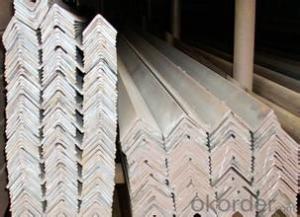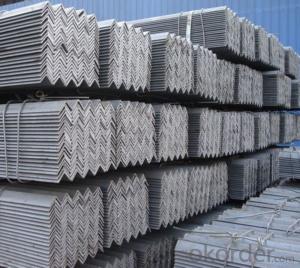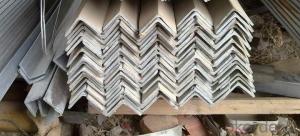DIN1028 galvanized angle steel for construction
- Loading Port:
- Tianjin
- Payment Terms:
- TT OR LC
- Min Order Qty:
- 25 m.t.
- Supply Capability:
- 10000 m.t./month
OKorder Service Pledge
OKorder Financial Service
You Might Also Like
Product Description:
Specifications of Equal Angle Steel
1.Standards: GB
2.Material: GBQ345 or Equivalent
3.Length: 6m, 12m
4. Size:
| Size (mm) | Mass (mm) | Size (mm) | Mass (mm) |
| 100*100*6 | 9.366 | 100*100*10 | 15.120 |
| 100*100*7 | 10.830 | 100*100*12 | 17.898 |
| 100*100*8 | 12.276 |
Usage & Applications of Equal Anlge Steel
Trusses;
Transmission towers;
Telecommunication towers;
Bracing for general structures;
Stiffeners in structural use.
Packaging & Delivery of Equal Angle Steel
1. Transportation: the goods are delivered by truck from mill to loading port, the maximum quantity can be loaded is around 40MTs by each truck. If the order quantity cannot reach the full truck loaded, the transportation cost per ton will be little higher than full load.
2. With bundles and load in 20 feet/40 feet container, or by bulk cargo, also we could do as customer's request.
3. Marks:
Color mark: There will be color marking on both end of the bundle for the cargo delivered by bulk vessel. That makes it easily to distinguish at the destination port.
Tag mark: There will be tag mark tied up on the bundles. The information usually including supplier logo and name, product name, made in China, shipping marks and other information request by the customer.
If loading by container the marking is not needed, but we will prepare it as customers' request.
*If you would like to get our price, please inform us the size, standard/material and quantity. Thank you very much for your attention.
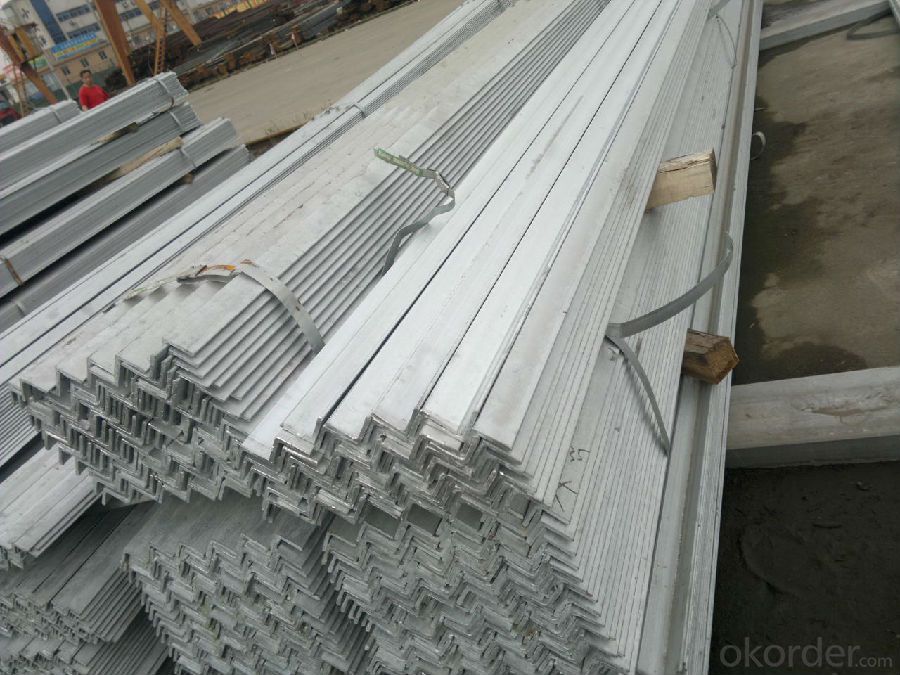
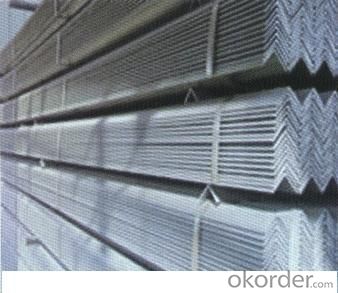
- Q:What are the typical lengths of steel angles?
- The typical lengths of steel angles vary depending on their intended use and application. However, steel angles are commonly available in standard lengths of 20 feet or 6 meters. These standard lengths are often preferred by manufacturers and construction companies due to their convenience and ease of transportation. Additionally, steel angles can be custom cut to specific lengths as per the requirements of a particular project.
- Q:How do steel angles contribute to the overall stiffness of a structure?
- The overall stiffness of a structure is enhanced by steel angles in various ways. Firstly, they offer additional support and rigidity to the framework. Their L-shape allows them to reinforce the corners and edges of different components like beams, columns, and trusses, preventing buckling, twisting, or bending under heavy loads or external forces. Furthermore, steel angles can be strategically positioned in crucial areas of the structure to efficiently resist and distribute loads. By incorporating steel angles as bracing elements, the structure's overall stiffness improves, reducing the risk of excessive deflection or deformation. This is especially vital for structures exposed to dynamic loads, such as wind or seismic forces, as the angles effectively resist and dissipate these forces throughout the structure. Moreover, steel angles can be interconnected to create a network of diagonal bracing, greatly enhancing the structure's stiffness and stability. This bracing system allows the angles to transfer loads from one component to another, effectively minimizing the possibility of failure or collapse. Additionally, using steel angles in this manner reduces the required material and weight, making the structure more cost-effective and efficient. To summarize, steel angles play a pivotal role in contributing to a structure's overall stiffness by providing reinforcement, supporting key components, and distributing loads. Their strength and versatility make them an essential element in designing and constructing various types of structures, guaranteeing stability, durability, and safety.
- Q:What are the maintenance requirements for steel angles?
- The maintenance requirements for steel angles typically involve regular cleaning and inspection for signs of corrosion or damage. It is important to remove any dirt or debris that may accumulate on the surface of the steel angles, as they can potentially lead to corrosion. Additionally, it is advisable to apply a protective coating or paint to prevent rusting. Routine inspections should be conducted to identify any signs of wear or structural issues that may require repairs or replacements.
- Q:What are the different specifications for steel angles?
- Steel angles, also referred to as angle irons or L-shaped bars, are utilized as versatile structural components in various industries. Their distinguishing feature is their L-shaped cross-section, which consists of two legs of either equal or unequal lengths. The dimensions of steel angles are determined by their leg lengths (L1 and L2) and thickness (T). The leg lengths can range from equal angles (L1 = L2) to unequal angles (L1 ≠ L2), with common leg lengths falling between 20mm and 200mm, and thicknesses typically ranging from 3mm to 20mm. In terms of material composition, steel angles are predominantly made from carbon steel, prized for its strength and durability. The choice of carbon steel grade employed is dependent on the specific application and the desired mechanical properties. Common grades include A36, A572, and A588. To ensure quality and consistency, steel angles are manufactured in adherence to various standards. These standards, such as ASTM (American Society for Testing and Materials), EN (European Norms), and JIS (Japanese Industrial Standards), establish guidelines for the chemical composition, mechanical properties, and tolerances of steel angles. Steel angles can possess different surface finishes to accommodate diverse applications and meet aesthetic requirements. Popular finishes include hot-dip galvanized, painted, or left as a mill finish (raw steel). Galvanized angles are coated with a layer of zinc for enhanced corrosion protection, while painted angles provide an additional layer of protection and can be customized in terms of color. To ensure conformity with required standards and suitability for structural applications, steel angles are subject to specific tolerances. These tolerances define acceptable deviations from the specified dimensions and can vary based on the manufacturing standard and the particular dimensions of the angle. In conclusion, the specifications for steel angles encompass dimensions (leg lengths and thickness), material composition (carbon steel grades), manufacturing standards (ASTM, EN, JIS), surface finish (galvanized, painted, mill finish), and tolerances. These specifications facilitate the selection of the appropriate steel angle for a given application, guaranteeing structural integrity and optimal performance.
- Q:Can steel angles be used for HVAC systems?
- Steel angles have the capability to be utilized in HVAC systems. Due to their strength and versatility, steel angles are frequently employed in construction and engineering applications. In the realm of HVAC systems, steel angles have numerous applications including providing support for ductwork, securing equipment, and establishing ventilation system frameworks. Steel angles possess durability, corrosion resistance, and the ability to withstand the weight and pressure of HVAC components. Moreover, they can be effortlessly welded or bolted together to form personalized structures and configurations. In conclusion, steel angles are an appropriate selection for HVAC systems due to their strength, durability, and design flexibility.
- Q:How do you prevent buckling of steel angles under compressive loads?
- To prevent buckling of steel angles under compressive loads, there are several measures that can be taken: 1. Increase the section modulus: The section modulus is a measure of the resistance of a cross-sectional shape to bending. By increasing the width or thickness of the steel angle, the section modulus can be increased, thereby enhancing its ability to resist compressive loads without buckling. 2. Increase the moment of inertia: The moment of inertia is a property of a cross-sectional shape that determines its resistance to bending. By increasing the moment of inertia, the steel angle becomes stiffer and less prone to buckling. This can be achieved by adding additional material or using a different cross-sectional shape with a greater moment of inertia. 3. Provide lateral support: Lateral support can be provided by adding bracing or stiffeners to the steel angle. This helps to distribute the compressive load and prevent buckling. The bracing or stiffeners should be designed to resist the applied loads and prevent any local distortions or deformations. 4. Use thicker or higher strength steel: By using thicker or higher strength steel, the steel angle can withstand higher compressive loads without buckling. Thicker steel has a higher resistance to bending, while higher strength steel can carry higher stresses before reaching its yield point. 5. Properly design and install connections: The connections between the steel angle and other structural members should be carefully designed and installed. Adequate connection details should be provided to ensure that the compressive load is transferred properly and that the steel angle is adequately supported. 6. Consider the effective length factor: The effective length factor is a parameter that accounts for the buckling behavior of a member. By properly considering the effective length factor in the design calculations, the risk of buckling can be minimized. 7. Conduct a thorough structural analysis: It is important to conduct a structural analysis to determine the expected compressive loads and potential buckling modes. By analyzing the structure using appropriate software or calculations, the necessary measures can be implemented to prevent buckling. Overall, preventing buckling of steel angles under compressive loads involves a combination of design considerations, material selection, and proper installation techniques. Following these measures will ensure the structural integrity and safety of the steel angles in various applications.
- Q:How do you inspect and measure the dimensions of a steel angle?
- To inspect and measure the dimensions of a steel angle, the following steps can be followed: 1. Tools required for the task are a measuring tape or ruler, a protractor, and a square. 2. Begin by examining the length of the steel angle. Place one end of the measuring tape or ruler on one side of the angle and extend it to the opposite side. Make sure the measuring tape is straight and aligned with the edge of the angle. Read the measurement in inches or millimeters to determine the length. 3. Proceed to measure the width or thickness of the angle. Position the measuring tape or ruler perpendicular to the length of the angle and measure the distance between the two parallel sides. This will provide the width measurement. 4. To measure the height or depth of the angle, position the measuring tape or ruler perpendicular to the width measurement. Again, ensure that the measuring tape is aligned with the edge of the angle and measure the distance between the two sides. This will yield the height measurement. 5. To verify the accuracy of the angle being 90 degrees, employ a square. Place the square against one side of the angle and ensure alignment with the adjacent side. Check if the corner of the angle fits perfectly within the square. If it does, the angle is indeed 90 degrees. If not, adjustments may be necessary. 6. Lastly, if the angle of the steel angle needs measurement, a protractor can be employed. Align one side of the protractor with one side of the steel angle and observe where the other side intersects with the protractor scale. Read the angle measurement to determine the exact angle. By adhering to these steps and utilizing the appropriate tools, one can effectively inspect and measure the dimensions of a steel angle.
- Q:How are steel angles measured and specified?
- Steel angles are typically measured and specified based on their dimensions and structural characteristics. The dimensions of a steel angle are determined by the length of its legs and the thickness of its material. The length of the legs refers to the vertical and horizontal sides of the angle, while the thickness represents the width of the angle. The dimensions of a steel angle are commonly expressed in two formats: the length of the legs followed by the thickness, or the thickness followed by the length of the legs. For instance, an angle with legs measuring 2 inches and a thickness of 1/4 inch can be specified as either 2" x 2" x 1/4" or 1/4" x 2" x 2". In addition to the dimensions, steel angles may also be specified by their structural characteristics. This includes the type of steel used, such as carbon steel or stainless steel, as well as the angle's load-bearing capacity and resistance to corrosion. Steel angles are widely used in construction, manufacturing, and various industrial applications. They are commonly used to provide structural support, as reinforcements, or as framing elements. By understanding how steel angles are measured and specified, architects, engineers, and builders can accurately select and utilize the appropriate angles for their projects.
- Q:Can steel angles be used in mezzanine flooring systems?
- Indeed, mezzanine flooring systems can incorporate steel angles. In the realm of mezzanine construction, steel angles are frequently employed as structural components due to their remarkable robustness and longevity. Whether utilized as supports, beams, or bracing elements, steel angles offer stability and an impressive load-bearing capacity to mezzanine flooring systems. Moreover, steel angles are adaptable and can be readily tailored and installed to meet precise design specifications. Additionally, they present a cost-effective and dependable solution for generating extra floor area in industrial and commercial edifices.
- Q:Are there any environmental concerns related to the production or disposal of steel angles?
- There exist numerous environmental concerns in relation to the production and disposal of steel angles. To begin with, the production of steel angles necessitates substantial amounts of energy and raw materials, such as iron ore and coal. The extraction of these resources can result in detrimental effects on the environment, including habitat destruction, deforestation, and air and water pollution. Furthermore, the manufacturing process itself emits greenhouse gases and other pollutants, contributing to climate change and air pollution. Moreover, the disposal of steel angles can pose problems. Steel is not easily biodegradable and may take hundreds of years to decompose. Inadequate disposal methods, such as landfilling or incineration, can lead to the release of toxic substances and contribute to soil and water contamination. To address these environmental concerns, various measures can be implemented. Firstly, enhancing the efficiency of steel production processes can reduce energy consumption and emissions. The utilization of recycled steel in the production of steel angles can also aid in decreasing the demand for raw materials and minimizing environmental impacts. Additionally, the implementation of proper waste management and recycling programs can help minimize the environmental footprint of steel angle disposal. In conclusion, although steel angles are crucial in numerous industries and construction, their production and disposal can have significant environmental implications. It is vital to prioritize sustainable practices and technologies to mitigate these concerns and promote a more environmentally friendly approach to the production and disposal of steel angles.
1. Manufacturer Overview |
|
|---|---|
| Location | |
| Year Established | |
| Annual Output Value | |
| Main Markets | |
| Company Certifications | |
2. Manufacturer Certificates |
|
|---|---|
| a) Certification Name | |
| Range | |
| Reference | |
| Validity Period | |
3. Manufacturer Capability |
|
|---|---|
| a)Trade Capacity | |
| Nearest Port | |
| Export Percentage | |
| No.of Employees in Trade Department | |
| Language Spoken: | |
| b)Factory Information | |
| Factory Size: | |
| No. of Production Lines | |
| Contract Manufacturing | |
| Product Price Range | |
Send your message to us
DIN1028 galvanized angle steel for construction
- Loading Port:
- Tianjin
- Payment Terms:
- TT OR LC
- Min Order Qty:
- 25 m.t.
- Supply Capability:
- 10000 m.t./month
OKorder Service Pledge
OKorder Financial Service
Similar products
New products
Hot products
Related keywords
